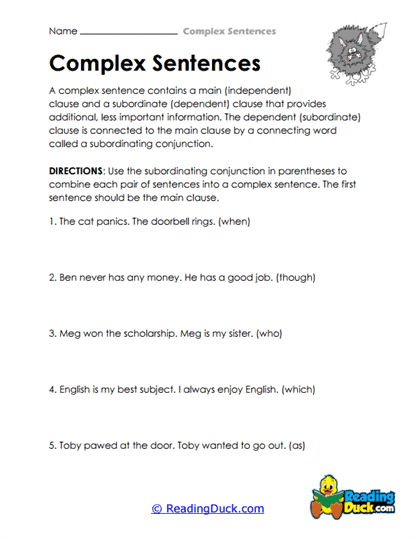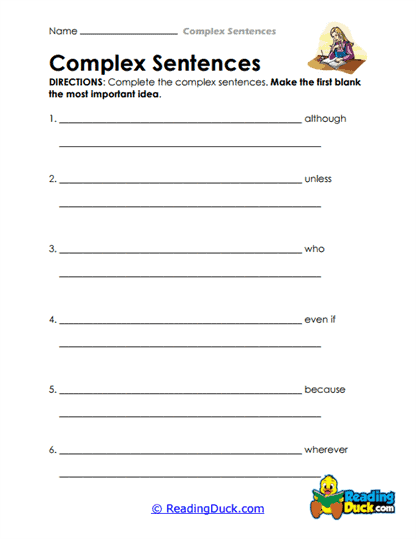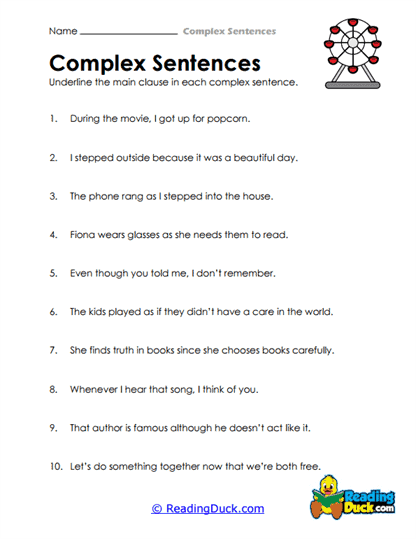Complex Sentences Worksheets
About Our Complex Sentences Worksheets
Our collection of Complex Sentences Worksheets is designed to help students master an essential element of writing: constructing complex sentences that enhance the quality and depth of their writing. These worksheets focus on understanding and using subordinating conjunctions, dependent and independent clauses, and the nuances of sentence structure to create more dynamic and engaging writing.
Aimed at students in elementary through middle school, this collection is perfect for classroom instruction, homeschooling, or independent study. Each worksheet provides clear, concise explanations of complex sentence components, coupled with exercises that reinforce learning through practical application. By the end of this series, students will confidently use complex sentences to add variety and sophistication to their writing, contributing to clearer communication and more compelling narratives.
What Are Complex Sentences?
Complex sentences are an important part of writing because they allow writers to combine ideas and convey relationships between them. A complex sentence is a sentence that includes one independent clause (a group of words that can stand alone as a sentence) and at least one dependent clause (a group of words that cannot stand alone as a sentence).
For example:
- Independent clause: I enjoy reading.
- Dependent clause: because it relaxes me.
- Complex sentence: I enjoy reading because it relaxes me.
In this example, the independent clause ("I enjoy reading") expresses a complete thought, while the dependent clause ("because it relaxes me") adds additional information but cannot stand alone. The key is that the clauses are not of equal importance, with the dependent clause providing context or details.
Key components of complex sentences:
- Independent clause: Can stand alone as a sentence.
- Dependent clause: Cannot stand alone; needs an independent clause to complete its meaning.
- Subordinating conjunction: Words like "because," "although," "while," and "since" that link the independent and dependent clauses.
By mastering complex sentences, students can:
- Show the relationship between ideas (cause and effect, contrast, condition, etc.).
- Add variety to their sentence structure.
- Improve the clarity and flow of their writing.
- Make their writing more sophisticated and nuanced, which is especially helpful in longer essays or creative writing tasks.
This skill enables students to create smoother transitions between ideas, enhancing both readability and depth in their written work.
Aligning with Writing Curriculum Objectives
Our Complex Sentences Worksheets are carefully aligned with key objectives found in writing curricula, helping students develop fundamental writing skills. Teachers can incorporate these worksheets into a variety of writing units, from narrative essays to research papers, and even creative writing exercises.
Here’s how these worksheets align with important writing goals:
- Sentence structure: Students learn how to construct more sophisticated sentences by combining independent and dependent clauses. They practice distinguishing between simple, compound, and complex sentences.
- Coherence and flow: Complex sentences help connect ideas more clearly, allowing students to write with better flow and coherence.
- Descriptive clarity: With complex sentences, students can add more detail and depth to their writing, making it easier for readers to understand the relationships between ideas or events.
- Syntax variation: Writing becomes more engaging when students vary their sentence structures, and complex sentences offer a way to do just that.
Educators can use these worksheets as a foundational part of broader writing units, whether students are crafting essays, reports, or creative stories. The exercises can be easily integrated into project-based learning environments, providing the opportunity for students to apply their skills in a real-world context.
Fostering Creativity and Self-Expression
Our Complex Sentences Worksheets go beyond teaching grammar—they empower students to express themselves more clearly and creatively. By learning how to construct complex sentences, students can:
- Add nuance to their writing by combining related ideas.
- Experiment with different styles of writing, using complex sentences to achieve different effects.
- Enhance their descriptive writing skills, adding depth to descriptions of people, places, and events.
For example, when students are tasked with descriptive writing or describing objects, complex sentences allow them to offer more detailed and vivid descriptions. Instead of writing a series of short, choppy sentences, students can craft flowing, connected sentences that bring their writing to life.
Consider the following example:
- Simple sentence: The car is red. It is parked outside.
- Complex sentence: The car, which is bright red, is parked outside the house, where it has been sitting all day.
In the second sentence, students use a combination of dependent clauses to add rich details and create a more engaging sentence. By using these worksheets, students will not only strengthen their grammatical understanding but also expand their ability to convey ideas in a more dynamic way.
Clear Instructions and Minimal Preparation
One of the key advantages of our Complex Sentences Worksheets is their ease of use. Each worksheet comes with clear instructions, making it simple for students to complete the exercises independently or with minimal teacher guidance. This makes the worksheets perfect for:
- In-class use: Teachers can incorporate them into lessons with minimal preparation, allowing more time to focus on interactive instruction.
- Homework assignments: The worksheets are structured so that students can complete them at home without confusion, reinforcing classroom learning.
- Homeschooling: Parents can easily integrate these worksheets into their homeschool curriculum, offering structured practice in writing.
- Independent study: Students looking to improve their writing on their own can use these worksheets to strengthen their sentence structure skills.
The exercises are also designed with flexibility in mind. Teachers can select individual worksheets to target specific learning goals or combine several to build a more comprehensive lesson on sentence structure. Each worksheet provides a mix of instruction and practice, ensuring that students can grasp the concepts and immediately apply what they’ve learned.
Adaptability for Various Learning Environments
Our Complex Sentences Worksheets are adaptable across various educational settings, offering flexibility for teachers, parents, and students alike. Whether you’re working in a traditional classroom, a virtual learning environment, or a homeschool setting, these worksheets can be used to enhance your writing curriculum.
- Classroom learning: Teachers can use the worksheets as part of daily grammar lessons or as supplemental material for students who need extra practice.
- Online learning: These worksheets can be easily uploaded to digital learning platforms for remote students to access and complete at their own pace.
- Homeschool settings: Parents can use the worksheets to provide structured writing practice, ensuring their children meet key writing objectives.
The worksheets are also easily customizable to meet individual student needs. Teachers and parents can modify the exercises by:
- Simplifying the instructions for younger or struggling learners.
- Adding more complex sentence combinations for advanced students.
- Encouraging students to apply complex sentences in their creative writing projects, helping them connect grammar lessons with broader writing tasks.
Conclusion
Incorporating Complex Sentences Worksheets into your writing curriculum is an effective way to enhance students' understanding of sentence structure, coherence, and creativity. These worksheets offer clear, practical exercises that allow students to practice constructing complex sentences, improving both their grammatical knowledge and their writing skills.
Whether used in the classroom, at home, or in independent study, this collection provides a structured, engaging approach to mastering an essential writing skill. With minimal preparation, adaptable content, and clear alignment with key learning objectives, these worksheets are a valuable tool for educators and students alike, promoting the growth of confident, capable writers who can express their ideas with clarity and sophistication.









